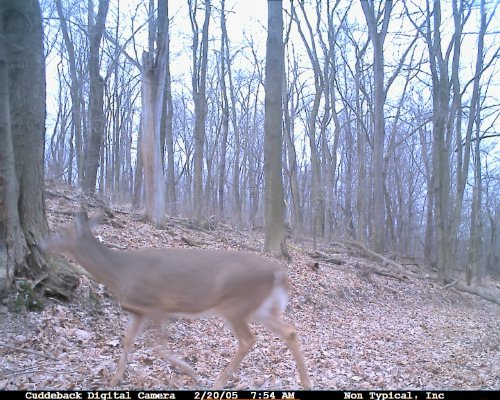|
Digital Cuddeback CameraFortunately I work close to a Cabela’s store so a trip over there at lunch time allowed me to purchase a Cuddeback camera. The camera got off to a bad start with me due to my own stupidity. I thought that there weren’t many things out there that still used those big D size batteries, so I purchased C size batteries for the camera. Well, as you can imagine, the Cuddeback camera uses those big D size batteries. Alright, that one was my fault; we’ll use the C batteries for something else. After finally getting the correct batteries I was ready to take some pictures around the house to get used to the camera. That is one of the things that I liked about my other digital cameras. I could take a bunch of pictures in the house while I learned how to operate them. I could then view the pictures, learn something, and then just delete them. Unfortunately it didn’t work this way with the Cuddeback camera. Even though the Cuddeback states that pictures can be viewed on portable TV’s or camcorders, TV’s or VCR’s, compatible digital cameras, a PC or a printer equipped with an image viewer I had nothing in my house that I could use to view the pictures. I do have a camcorder, four TV’s, two VCR’s, two digital cameras, two computers and two printers in my house, but none of these were capable of viewing the pictures from the Cuddeback camera. There aren’t any cables included with the Cuddeback. Off I went to the store to buy a compact flash card and a card reader so that I could see the pictures from the camera. Let’s take a look at some of the features of the camera. The Cuddeback camera has two available image resolutions, 640x480 and 1280x1024 pixels. If you do not use a compact flash card the images are the smaller size whereas if you use a card, the pictures are the larger size. You do not have a choice. A cable and Torx head screws are provided with the camera to attach it to a tree, but a lock is not provided with the camera. A shackle is provided on the bottom of the unit for a small padlock to lock the enclosure. There is no way provided to lock the Cuddeback to the tree. The flash seems stronger than the flashes on my first two digital cameras. It makes an audible pop sound when it is triggered, but I doubt that it would spook deer. The flash almost seemed too bright. Most of the pictures that we took were somewhat washed out. They did not have a nice clear image. I think that the flash was too much. If we were real close to the camera, the pictures were very poor. You can take a look at some pictures from our Cuddeback here. The Cuddeback does seem to trigger faster than the EagleEye. This is probably due to the fact that the Cuddeback doesn’t have to power up and open a shutter cover. Camera placement along trails may be less critical even though I have not had a problem with power up time causing problems with the EagleEye. With all digital scouting cameras it is wise to set the camera up to try to catch the animals walking at an angle to the camera. The delay between pictures can easily be set to between one and sixty minutes. The controls and set-up of the camera were not very difficult, but like any digital camera, a read through of the instructions is needed. The Cuddeback has two operating modes, an EZ mode and an advanced mode. The EZ mode is for basic camera operation, whereas the advanced mode allows you to use some of the other features of the camera. I did not get the opportunity to try the advanced mode. Both the Cuddeback and the EagleEye are set up so that they will default to an operational mode after being left alone for a while as long as the batteries are good and they are turned on. This helps eliminate the possibility of having them out and no pictures being taken. This is a very good feature. Unfortunately, I only got one picture of a deer before the mode button stopped working on the Cuddeback. This did not give me the opportunity to check battery life or any of the advanced features of the camera. I had to return the camera. The picture quality from the Cuddeback was disappointing and it was frustrating that I could not see the pictures without buying something else. That's not to mention that the camera did not stay operational long enough for me to test it. This model was the 1.3 MP unit and it is no longer offerred by Cuddeback.
|

